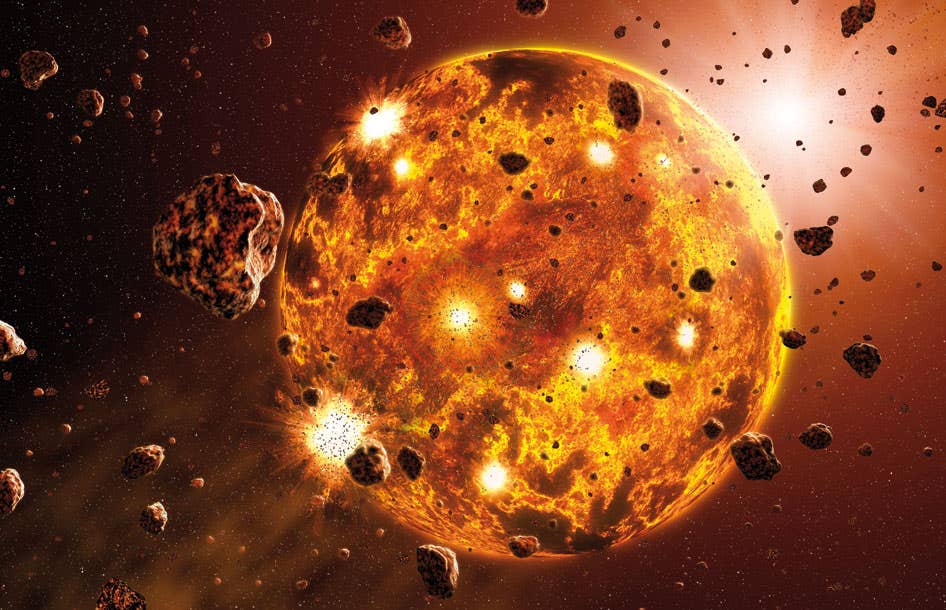Scientists finally unravel the secrets of planet formation
At the heart of the quest to understand how life originates in our universe, is the mystery of how Earth-like planets come into existence

[Sept 3, 2023: Staff Writer, The Brighter Side of News]
Using simulated models, researchers could hypothesize the growth trajectory of the interstellar dust - the primordial ingredient of planets. (CREDIT: Alan Brandon)
The quest to understand how life originates in our universe is as old as humanity itself. At the heart of this mystery is the conundrum of how Earth-like planets come into existence.
New revelations from the DG Tau protostar may have taken us one step closer to solving this puzzle.
Setting the Scene: The Protoplanetary Puzzle
Planetary formation is believed to kick off in the cosmic dance where interstellar dust and gas unite in a protoplanetary disk encircling a young protostar. An age-old conundrum has been pinpointing where, when, and how this celestial event begins.
Related Stories
There's a telling sign of a planet's birth – its gravitational influence etches ring-like patterns onto the said disk. The Atacama Large Millimeter/submillimeter Array (ALMA) has provided scientists with a bird's eye view of these patterns in numerous protoplanetary disks, hinting at burgeoning planets.
However, to truly demystify the planetary birth process, scientists needed to observe a pristine disk – untouched by the gravitational pull of budding planets. This task was a formidable challenge due to the elusive nature of such disks. Until now.
DG Tau: The Protagonist of Our Story
In a groundbreaking study titled "Dust Enrichment and Grain Growth in a Smooth Disk around the DG Tau Protostar Revealed by ALMA Triple Bands Frequency Observations," published in The Astrophysical Journal, an international research consortium set their sights on the fledgling protostar, DG Taurus, more endearingly known as DG Tau.
An image of the radio wave emission strength from the disk around DG Taurus, observed with ALMA. Rings have not yet formed in the disk, suggesting that it is just before planet formation. (CREDIT: ALMA (ESO/NAOJ/NRAO), S. Ohashi et al.)
With ALMA’s unparalleled prowess, they mapped out radio emissions from dust in the protostar's surrounding disk at a 1.3 mm wavelength, boasting an extraordinary spatial resolution of 0.04 arcsec. The result? A revelation that the DG Tau’s disk was smooth, devoid of the tell-tale ring patterns commonly found around its older counterparts.
In layman’s terms, DG Tau's disk appeared untouched by planetary formation, potentially offering an unprecedented view into the prelude of this cosmic phenomenon.
ALMA 1.3 mm dust continuum image. The intensity is converted to the brightness temperature by assuming the Rayleigh–Jeans approximation. (CREDIT: The Astrophysical Journal)
Delving Deeper: The Art of Cosmic CSI
With the stage set, the scientists embarked on a more intricate investigation, exploring the disk at varying wavelengths, specifically at 0.87 mm, 1.3 mm, and 3.1 mm. The motive? To decode the disk's dust size and density.
Here's the crux: Dust's interaction with radio waves varies based on its size and density. By juxtaposing observational data with simulated models featuring an array of dust configurations, researchers could hypothesize the growth trajectory of the interstellar dust - the primordial ingredient of planets.
ALMA images of the Stokes I, PI, Stokes Q, and Stokes U emission at wavelengths of 0.87 mm (Top panel) and 3.1 mm (Bottom panel). The contours represent the Stokes I emission of [1, 10, 30, 50] K for 0.87 mm and [1,10,30] K for 3.1 mm. The bottom left corner of each panel shows the beam sizes. (CREDIT: The Astrophysical Journal)
Their findings were staggering. Contrary to established theories positing that planetary formation initiates in the inner sanctum of the disk, the evidence pointed outward. The disk's peripheries (beyond approximately 40 astronomical units) boasted larger dust particles, insinuating a more matured phase of planetary genesis.
Conversely, the inner regions, although housing smaller dust particles, exhibited a dust-to-gas ratio surging beyond the norm of interstellar realms by a factor of ten. Additionally, this dust is steadily settling onto the disk's midplane, hinting that it's amassing materials in preparation for future planet birth.
ALMA images of polarization fraction (PI/Stokes I) for wavelengths of 0.87 mm (top panel) and 3.1 mm (bottom panel). The gray bars show the direction of the polarization vectors. The contours indicate the Stokes I emission. The bottom left corner of each panel shows the beam sizes. (CREDIT: The Astrophysical Journal)
Thanks to ALMA's unparalleled spatial resolution and its ability to detect radio waves, including polarized light across varied wavelengths, this study has shattered the mold. For the first time, humanity has been privy to the intricacies of a "smooth disk", unmarked by planetary signatures. This opens the door to new revelations about planetary cradles that remained beyond the reach of earlier theoretical or observational endeavors.
A Scientist's Perspective
To offer a lens into the magnitude of this discovery, Satoshi Ohashi, a leading scientist in the field, shared his insights: "ALMA's contributions in unveiling a plethora of disk structures, highlighting the presence of planets, are unparalleled.
Deprojected radial profiles at ALMA Bands 7, 6, and 3. The intensity is shown as Jy beam−1 (top panel) and as the brightness temperature assuming the Rayleigh–Jeans approximation (bottom panel). The shadowed regions correspond to the 1σ errors including the rms noise levels and flux uncertainties of 10% for Bands 7 and 6, and 5% for Band 3. (CREDIT: The Astrophysical Journal)
Yet, to address the primordial query, 'How does planet formation commence?' the imperative lies in observing a smooth disk, untouched by planetary signatures. This research is seminal in illuminating the initial conditions underpinning planetary birth."
In the vast tapestry of the cosmos, the birth of a planet is a monumental event. With each scientific discovery, we edge closer to understanding our own origins and our place in this boundless expanse. DG Tau's revelations offer not just answers, but kindle newer questions, driving our insatiable quest for knowledge. As we continue this cosmic journey, the universe, piece by piece, unfolds its secrets to us.
For more science stories check out our New Discoveries section at The Brighter Side of News.
Note: Materials provided above by the The Brighter Side of News. Content may be edited for style and length.
Like these kind of feel good stories? Get the Brighter Side of News' newsletter.
Joseph Shavit
Head Science News Writer | Communicating Innovation & Discovery
Based in Los Angeles, Joseph Shavit is an accomplished science journalist, head science news writer and co-founder at The Brighter Side of News, where he translates cutting-edge discoveries into compelling stories for a broad audience. With a strong background spanning science, business, product management, media leadership, and entrepreneurship, Joseph brings a unique perspective to science communication. His expertise allows him to uncover the intersection of technological advancements and market potential, shedding light on how groundbreaking research evolves into transformative products and industries.



